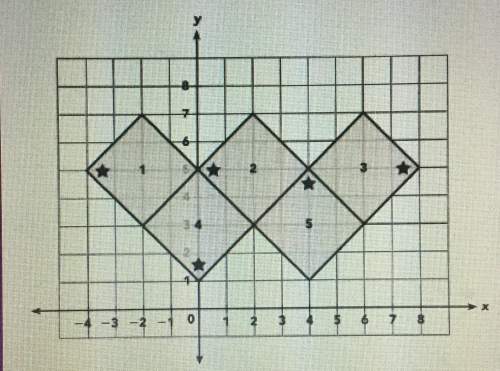
Mathematics, 18.03.2021 01:50 monayemcnett11
100 points plz answer with a compete answer or you will get reported :)
1. Describe and extend each sequence.
A. The height, in feet, of windowsills in a high-rise building is represented by this sequence:
3, 15, 27, 39, ...
Describe the rule for the sequence.
Find the next two terms of the sequence. Show your work.
B. Mason put sticky notes on some pages of his math book. The page numbers form this sequence:
3, 5, 8, 13, 21, 34, ...
Describe the rule for the sequence.
Find the next two terms of the sequence. Show your work.
THE EXPLICIT FORMULA
2. Use the following arithmetic sequence and the formula an = a1 + (n – 1)d to answer the questions below.
123, 116, 109, 102, 95, ...
Part I: Find the value of each of the following:
a1 = and d =
Part II: Find the explicit formula. Show your work.
Part III: Use the explicit formula you found in Part II to find the value of the 100th term in the sequence, a100. Show your work.
3. State whether each sequence is arithmetic or geometric, and then find the explicit and recursive formulas for each sequence. (10 points: 5 points each)
Formulas:
Part I: The total value of a collection of nickels can be described by this sequence:
5, 10, 15, 20, 25, 30, ...
Type of sequence:
Explicit formula:
Recursive formula:
Part II: The number of rats living in an abandoned building increases each year. The total number of rats can be described by this sequence:
2, 6, 18, 54, 162, ...
Type of sequence:
Explicit formula:
Recursive formula:
4. A stone nudged off the Royal Gorge Bridge near Cañon City, Colorado, falls 1053 feet before hitting water. Because its speed increases as it falls, the distance it travels each second increases. During the first second, it drops 16 feet. During the next second, it drops an additional 48 feet. During the third second, it drops another 80 feet. The distances traveled each second form an arithmetic sequence:
16, 48, 80, ...
Part I: How far does the stone fall during the 5th second? Find and use the explicit formula.
What is the first term of the sequence?
What is d, the common difference?
Write the explicit formula in function notation. Use f(n) = f(1) + (n – 1)d, where f(1) represents the first term.
Use the explicit formula to find the distance the stone travels in the 5th second.
Part II: The table below shows the values in the sequence you already know. Use the explicit formula or the common difference to complete the table for the first 7 seconds.
Time (s) 1 2 3 4 5 6 7
Distance (ft) 16 48 80 144
Part III: Use the table from part II to answer the questions.
The values in the table form a(n) sequence.
The term values are shown in the row, and the term numbers are shown in the row.
This sequence is associated with a(n) function.
The domain of the function is the set of time values: .
5. Your track coach is letting you choose between two different workouts.
A: Run 10 minutes on Monday and double that time every day through Friday.
B: Run 30 minutes on Monday and add 10 minutes every day through Friday.
What type of function is represented by plan A? By plan B? Which plan should you choose if you have plans Friday night and want a short workout on Friday? Why? Create a table to justify your answer.
Plan A: function
Plan B: function
I would choose plan because .
Plan A minutes Plan B minutes
Monday
Tuesday
Wednesday
Thursday
Friday
6. Prove that linear functions grow by equal differences over equal intervals.
Part I. This is the graph of . Use the graph to show that equal intervals of x-values have equal differences of y-values.
a) Think about an interval on the x-axis starting with p and ending with p + k. What is the difference between the x-values? What is the difference between the y-values for these x-values? Complete the tables using .
Interval between p = 2 and p + k = 6 Difference
x-value 2 6 4
y-value –2
Interval between p = 10 and p + k = 14 Difference
x-value 10 14
y-value
b) The difference in the x-values for each interval is . This value is constant because
difference = (p + k) – p = .
c) The difference in the y-values for each interval is . This value is also constant because
\begin{aligned} \text{difference } &= -\frac{1}{2}(p + k) + 10 - (-\frac{1}{2}p + 10) \\ &= -\frac{1}{2}p - \frac{1}{2}k + 10 + \frac{1}{2}p - 10 \\ &= -\frac{1}{2}k \end{aligned}
difference
=−
2
1
(p+k)+10−(−
2
1
p+10)
=−
2
1
p−
2
1
k+10+
2
1
p−10
=−
2
1
k
d) Does your answer in part c depend on p? If not, what does it depend on?

Answers: 2


Other questions on the subject: Mathematics

Mathematics, 21.06.2019 14:00, tristina20
Use the inverse of the function y=x^2-18x to find the unknown value [tex]y = \sqrt{bx + c \: + d} [/tex]
Answers: 3

Mathematics, 21.06.2019 14:30, sierram298
The multiplication property of zero states that the product of any number and 0 is 0. what must be true about either a or b to make ab=0
Answers: 1

You know the right answer?
100 points plz answer with a compete answer or you will get reported :)
1. Describe and extend each...
Questions in other subjects:





Law, 07.10.2020 14:01

Biology, 07.10.2020 14:01

Chemistry, 07.10.2020 14:01







